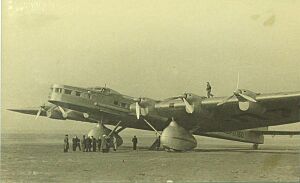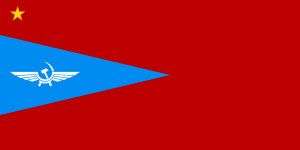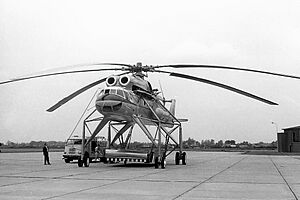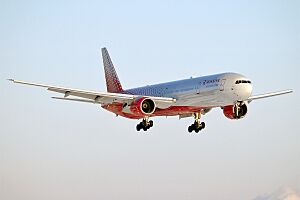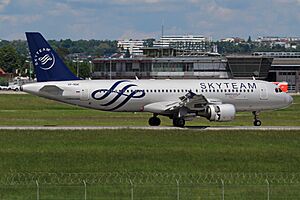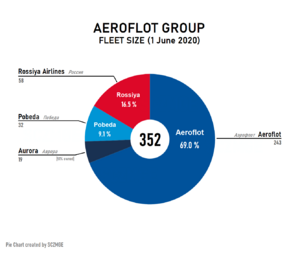Aeroflot facts for kids
 |
|
| Founded | 3 February 1923 |
|---|---|
| Commenced operations | 15 July 1923 |
| Hubs |
|
| Focus cities |
|
| Frequent-flyer program | Aeroflot Bonus |
| Alliance |
|
| Subsidiaries |
|
| Fleet size | 171, excluding subsidiaries |
| Destinations | 104 (airline group) |
| Headquarters | Moscow, Russia |
| Key people | Sergei Alexandrovsky (Chairman, CEO) |
| Revenue | |
| Operating income | |
| Net income | |
| Total assets | |
| Total equity | |
| Employees | 30,328 (Aeroflot Group) |
| Website | |
PJSC Aeroflot – Russian Airlines (Russian: ПАО «Аэрофло́т — Росси́йские авиали́нии», PAO Aeroflot — Rossiyskiye avialinii), commonly known as Aeroflot (English: /ˈɛəroʊˌflɒt/ or ![]() i/ˌɛəroʊˈflɒt/; Russian: Аэрофлот, transl. "air fleet", pronounced [ɐɛrɐˈfɫot]), is the flag carrier and the largest airline of Russia. Aeroflot is headquartered in the Central Administrative Okrug, Moscow, with its hub being Sheremetyevo International Airport. The Federal Agency for State Property Management, an agency of the Government of Russia, owns 73.77% of the company, with the rest of the shares being public float.
i/ˌɛəroʊˈflɒt/; Russian: Аэрофлот, transl. "air fleet", pronounced [ɐɛrɐˈfɫot]), is the flag carrier and the largest airline of Russia. Aeroflot is headquartered in the Central Administrative Okrug, Moscow, with its hub being Sheremetyevo International Airport. The Federal Agency for State Property Management, an agency of the Government of Russia, owns 73.77% of the company, with the rest of the shares being public float.
The airline was founded in 1923, making Aeroflot one of the oldest active airlines in the world. During the time of the Soviet Union, Aeroflot was one of the largest airlines in the world. In 1992, following the dissolution of the Soviet Union, Aeroflot was divided into approximately 400 regional airlines informally known as Babyflots and was restructured into an open joint-stock company.
It has a market share in Russia of approximately 39%. Including subsidiaries, the company carried 47.3 million passengers in 2023. Aeroflot also owns Rossiya Airlines and Pobeda, a low-cost carrier.
The Aeroflot fleet, excluding subsidiaries, includes 171 airplanes: 112 Airbus planes and 59 Boeing planes. The company plans on making the Yakovlev MC-21 its flagship plane, with deliveries expected to start in 2025 or 2026.
Contents
History
Early history of Soviet civil aviation
On 17 January 1921, the Sovnarkom of the Russian Soviet Federative Socialist Republic published "About Air Transportation". The document signed by its chair Vladimir Lenin set out the basic regulations on air transport over the territory of the RSFSR. The document was significant as it was the first time that a Russian state had declared sovereignty over its airspace. In addition, the document defined rules for the operation of foreign aircraft over the Soviet Union's airspace and territory. After Lenin issued an order, a State Commission was formed on 31 January 1921 for the purpose of civil aviation planning in the Soviet Union.
As a result of the commission's plans, Glavvozdukhflot (Russian: Главвоздухфлот (Главное управление воздушного флота), Chief Administration of the Civil Air Fleet) was established, and it began mail and passenger flights on the Moscow-Oryol-Kursk-Kharkov route on 1 May 1921 using Sikorsky Ilya Muromets aircraft. This was followed by the formation of Deruluft in Berlin on 11 November 1921, as a joint venture between the Soviet Union and Germany. The company, whose aircraft were registered in both Germany and the Soviet Union, began operations on 1 May 1922 with a Fokker F.III flying between Königsberg and Moscow. The service was initially operated twice a week and restricted to the carriage of mail.
On 3 February 1923, Sovnarkom approved plans for the expansion of the Red Air Fleet, and it is this date which was officially recognised as the beginning of civil aviation in the Soviet Union. On 9 February 1923, the Council of Labour and Defence passed a resolution to create the Civil Air Fleet of the USSR. After a resolution of the Central Committee of the Communist Party of the Soviet Union, the Enterprise for Friends of the Air Fleet (ODVF) was founded on 8 March 1923.
Dobrolyot
Dobrolyot (Russian: Добролёт) was formed on 17 or 25 March 1923. The artist Alexander Rodchenko became involved in the ODVF at this time. He designed posters encouraging citizens to buy stock in Dobrolet and the famous "Winged Hammer and Sickle" logo still used by Aeroflot.
Regular flights by Dobrolyot from Moscow to Nizhniy Novgorod commenced on 15 July 1923. During the same period, an additional two airlines were established; Zakavia being based in Tiflis, and Ukrvozdukhput based in Kharkov. In 1923, an agreement was signed establishing a subdivision of Dobrolyot to be based in Tashkent, which would operate to points in Soviet Central Asia. Services between Tashkent and Alma Ata began on 27 April 1924, and by the end of 1924 the subdivision had carried 480 passengers and 500 kilograms (1,100 lb) of mail and freight, on a total of 210 flights.
In March 1924, Dobrolyot began operating flights from Sevastopol to Yalta and Yevpatoriya in Crimea. Dobrolyot's route network was extended during the 1925–1927 period to include Kazan and regular flights between Moscow and Kharkov were inaugurated. Plans were made for Dobrolyot flights to Kharkov to connect with Ukrvozdukhput services to Kiev, Odessa and Rostov-on-Don. In 1925, Dobrolyot operated 2,000 flights over a distance of 1,000,000 kilometres (620,000 mi), carrying 14,000 passengers and 127,500 kilograms (281,100 lb) of freight, on a route network extending to 5,000 kilometres (3,100 mi). Dobrolyot was transformed from a Russian to an all-Union enterprise on 21 September 1926 as a result of Sovnarkom resolutions, and in 1928 Dobrolyot was merged with Ukrvozdukhput; the latter having merged with Zakavia in 1925.
Formation of Aeroflot
Responsibility for all civil aviation activities in the Soviet Union came under the control of the Chief Directorate of the Civil Air Fleet on 25 February 1932, and on 25 March 1932 the name "Aeroflot" was officially adopted for the entire Soviet Civil Air Fleet. The Communist Party of the Soviet Union Congress in 1933 set out development plans for the civil aviation industry for the following five years, with air transportation becoming one of the primary means of transportation in the Soviet Union, linking all major cities. The government also implemented plans to expand the Soviet aircraft industry to make it less dependent on foreign built aircraft; in 1930, 50% of aircraft flying services in the Soviet Union were of foreign manufacture. Expansion of air routes which had taken shape in the late 1920s, continued into the 1930s. Local (MVL) services were greatly expanded in Soviet Central Asia and the Soviet Far East, which by the end of the second five-year plan in 1937 was 35,000 kilometres (22,000 mi) in length out of a total network of 93,300 kilometres (58,000 mi). The agreement between the Soviet Union and Germany relating to Deruluft expired on 1 January 1937 and wasn't renewed, which saw the joint venture carrier ceasing operations on 1 April 1937. On that date Aeroflot began operations on the Moscow to Stockholm route, and began operating the ex-Deruluft route from Leningrad to Riga utilising Douglas DC-3s and Tupolev ANT-35s (PS-35s). Flights from Moscow to Berlin, via Königsberg, were suspended until 1940, when they were restarted by Aeroflot and Deutsche Luft Hansa as a result of the signing of the Molotov–Ribbentrop Pact, and they continued until the opening of the Eastern Front in World War II in 1941.
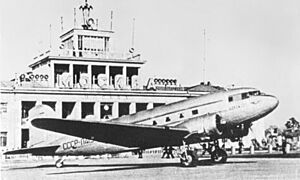
Under the third five-year plan, which began in 1938, civil aviation development continued, with improvements to airport installations being made and construction of airports being commenced. In addition to the expansion of services between the Soviet Union's main cities, local routes (MVL) were also expanded, and by 1940, 337 MVL routes had operations on a scheduled basis. Serial production of the Lisunov Li-2 (license-built Douglas DC-3) commenced in 1939, and the aircraft became the backbone of the Aeroflot fleet on mainline trunk routes. The day after Operation Barbarossa, the invasion of the Soviet Union by Nazi Germany, on 22 June 1941, the Sovnarkom placed the Civil Air Fleet under the control of Narkomat, leading to the full-scale mobilisation of Aeroflot crews and technicians for the Soviet war effort. Prior to the invasion, the Aeroflot network extended over 146,000 kilometres (91,000 mi), and amongst the longest routes being operated from Moscow were those to Tbilisi (via Baku), Tashkent and Vladivostok. Aeroflot aircraft, including PS-35s and PS-43s, were based at Khodynka Aerodrome in Moscow; and important missions undertaken by Aeroflot aircraft and crews included flying supplies to the besieged cities of Leningrad, Kyiv, Odessa and Sevastopol. During the Battle of Stalingrad, between August 1942 and February 1943, Aeroflot operated 46,000 missions to Stalingrad, ferrying in 2,587 tonnes (5,703,000 lb) of supplies and 30,000 troops. Following the defeat of the Wehrmacht, 80 Junkers Ju 52/3ms were captured from the Germans, and were placed into the service of the Civil Air Fleet, and after the war were placed into regular service across the Soviet Union. Whilst civil operations in European Russia west of the front line, which ran from Leningrad to Moscow to Rostov-on-Don, were prevented from operating because of the war, services from Moscow to the Urals, Siberia, Central Asia, and other regions which were not affected by the war, continued. By the end of the war, Aeroflot had flown 1,595,943 special missions, including 83,782 at night, and carried 1,538,982 men and 122,027 tonnes (269,023,000 lb) of cargo.
Aeroflot during the Cold War
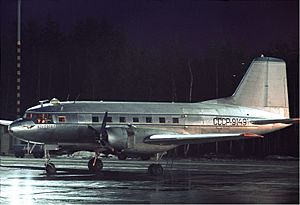
At the end of World War II, the Soviet government repaired and rebuilt essential airport infrastructure, and it strengthened the Aeroflot units in the European part of the Soviet Union. In 1945, Aeroflot carried 537,000 passengers, compared with 359,000 in 1940. The government made it a priority in the immediate postwar years to expand services from Moscow to the capital of each of the Republics of the Soviet Union, in addition to important industrial centres on the country and transferred to Aeroflot many Lisunov Li-2s, which became the backbone of the Aeroflot fleet. The Ilyushin Il-12 entered service on Aeroflot's all-Union scheduled routes on 22 August 1947, and supplemented already existing Li-2 services. The original Ilyushin Il-18 entered service around the same time as the Il-12, and was operated on routes from Moscow to Yakutsk, Khabarovsk, Vladivostok, Alma Ata, Tashkent, Sochi, Mineralnye Vody and Tbilisi. By 1950, the Il-18 was withdrawn from service, replaced by Il-12s. MVL and general aviation services received a boost in March 1948, when the first Antonov An-2s were delivered and entered service in Central Russia. Development of MVL services over latter years was attributed to the An-2, which was operated by Aeroflot in all areas of the Soviet Union.

Aeroflot's route network had extended to 295,400 kilometres (183,600 mi) by 1950, and it carried 1,603,700 passengers, 151,070 tonnes (333,050,000 lb) of freight and 30,580 tonnes (67,420,000 lb) of mail that year. Night flights began in the same year, and the fifth five-year plan, covering the period 1951–1955, emphasised Aeroflot expanding night-time operations, which vastly improved aircraft utilisation. By 1952, 700 destinations in the Soviet Union received regular flights from Aeroflot. On 30 November 1954, the Ilyushin Il-14 entered service, and the aircraft took a leading role in the operation of Aeroflot's all-Union services. The number of passengers carried in 1955 increased to 2,500,000, whilst freight and mail carriage also increased, to 194,960 and 63,760 tons, respectively. By this time, Aeroflot's route network covered a distance of 321,500 kilometres (199,800 mi). The 20th Congress of the Communist Party of the Soviet Union, held in 1956, included plans for Aeroflot services to be dramatically increased 3.8 times, with a target of 16,000,000 annual passengers by 1960. To meet these goals, Aeroflot introduced higher capacity turbojet and turbine-prop aircraft on key domestic routes, and on services to Aeroflot destinations abroad. A major step for Aeroflot occurred on 15 September 1956 when the Tupolev Tu-104 jet aircraft entered service on the Moscow-Omsk-Irkutsk route, marking the world's first sustained jet airline service. The airline began international flights with the type on 12 October 1956 under the command of Boris Bugayev with flights from Moscow to Prague. The aircraft placed Aeroflot in an enviable position, as airlines in the West had operated throughout the 1950s with large piston-engined aircraft. By 1958, the route network covered 349,200 kilometres (217,000 mi), and the airline carried 8,231,500 passengers, and 445,600 tons of mail and freight, with fifteen percent of all-Union services being operated by jet aircraft.
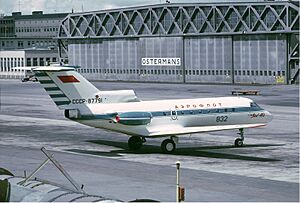
Aeroflot introduced the Antonov An-10 and Ilyushin Il-18 in 1959, and together with its existing jet aircraft, the airline was able to extend services on modern aircraft to twenty one cities by 1960. The Tupolev Tu-114, then the world's largest airliner, entered service with the Soviet carrier on 24 April 1961 on the Moscow-Khabarovsk route; covering a distance of 6,980 kilometres (4,340 mi) in 8 hours 20 minutes. The expansion of the Aeroflot fleet saw services with modern aircraft being extended to forty one cities in 1961, with fifty percent of all-Union services being operated by these aircraft. This fleet expansion also saw the number of passengers carried in 1961 skyrocketing to 21,800,000. Further expansion came in 1962 when both the Tupolev Tu-124 and Antonov An-24 entered regular service with Aeroflot on various medium and short-haul routes. By 1964, Aeroflot operated direct flights from Moscow to 100 cities, from Leningrad to 44 cities, and from Kyiv to 38 cities. The airline also operated direct flights from Mineralnye Vody to 48 cities across the Soviet Union, denoting the importance of the operation of holiday aircraft services to Aeroflot. Statistics for the same year showed Aeroflot operating an all-Union route network extending over 400,000 kilometres (250,000 mi), and carrying 36,800,000 passengers.
By 1966, Aeroflot carried 47,200,000 passengers over a domestic route network of 474,600 kilometres (294,900 mi). For the period of the eighth five-year plan, which ran from 1966 to 1970, Aeroflot carried a total of 302,200,000 passengers, 6.47 billion tons of freight and 1.63 billion tons of mail. During the five-year plan period, all-Union services were extended over an additional 350 routes; an additional 1,000 MVL routes were begun, and 40 new routes were opened up with all-cargo flights. In 1967, the Ilyushin Il-62 and Tupolev Tu-134 were introduced, and in September 1968 the Yakovlev Yak-40 regional jet began operations on short-haul services. That same year, the Il-62 inaugurated the long-delayed service between Moscow and New York, which finally began in July and was operated by Aeroflot and Pan Am jointly. According to the book The Aeroflot Story: From Russia With Luck: "This business relationship became an acrimonious affair in which both parties complained it had been wronged by the other. Pan Am accused the Soviets of illegally siphoning away Moscow-to-New York passengers, whilst in turn; Aeroflot accused US consular officials in Russia of having steered passengers to Pan Am flights." In 1968, the company opened its first office in the United States.
By 1970, the last year of the five-year plan period, Aeroflot was operating flights to over 3,500 destinations in the Soviet Union, and at the height of the 1970 summer holidays season, the airline was carrying approximately 400,000 passengers per day, and 90% of passengers were being carried on propeller-turbine and jet aircraft. In March 1970, Aeroflot had amassed a route network that was 600,000 kilometres (370,000 miles) long, a quarter of which covered international destinations. At this time, the carrier had agreements with 59 countries but it only served 54 of them, including 55 destinations. In January 1971, the Central Administration of International Air Traffic (Russian: Центральное управление международных воздушных сообщений) (TsUMVS) was established within the framework of IATA, and became the sole enterprise authorised to operate international flights. Abroad, the airline was known as Aeroflot Soviet Airlines. In 1976, Aeroflot carried its 100 millionth passenger. Its flights were mainly concentrated around the Soviet Union, but the airline also had an international network covering five continents: North and South America, Europe, Africa and Asia. The network included countries such as the United States, Canada, United Kingdom, Spain, Cuba, Mexico and the People's Republic of China.
Aeroflot service between the Soviet Union and the United States was interrupted from 15 September 1983 until 2 August 1990, following an executive order by U.S. President Ronald Reagan revoking Aeroflot's license to operate flights into and out of the United States following the downing of Korean Air Lines Flight 007 by the Soviet Air Force. Flights resumed in April 1986. At the start of the 1990s, Aeroflot reorganised again giving more autonomy to territorial divisions. R. E. G. Davies, former curator of the Smithsonian Institution, claims that by 1992 Aeroflot had over 600,000 people operating over 10,000 aircraft.
Other functions
Once the world's largest carrier, Aeroflot did not restrict its operations to the transportation of passengers, but monopolised all civil aviation activities within the Soviet Union. Apart from passenger transportation that covered a domestic network of over 3,600 villages, towns and cities, activities undertaken by the airline that were labelled as "non-transport tasks" included air ambulance; aerial application; heavy lifting for the Soviet Space Agency; offshore oil platform support; exploration and aeromagnetic survey for natural resources; support for construction projects; transport of military troops and supplies (as an adjunct to the Soviet Air Force); atmospheric research; and remote area patrol. It operated hundreds of helicopters and cargo aircraft in addition to civil airliners. It also operated the Soviet equivalent of a presidential aircraft and other VIP transports of government and Communist party officials. Aeroflot was also responsible for such services as ice patrol in the Arctic Ocean and escorting of ships through frozen seas; oil exploration; power line surveillance; and transportation and heavy lifting support on construction projects. For the latter tasks, Aeroflot used, in addition to smaller helicopters, the Mil Mi-10 flying crane capable of lifting 11,000 to 14,000 kilograms (24,000 to 31,000 lb). Hauling of heavy cargo, including vehicles, was performed by the world's largest operational helicopter, the Mil Mi-26. Its unusual eight-blade rotor enabled it to lift a maximum payload of 20 tons. The medium- and long-range passenger- and cargo aircraft of Aeroflot were also part of the strategic air transport reserve, ready to provide immediate airlift support to the armed forces. Short-range aircraft and helicopters were available for appropriate military support missions.
Post-Soviet Aeroflot

After the Dissolution of the Soviet Union in 1991, service expanded significantly. Up until that time, Aeroflot had been the only establishment providing air services throughout the Soviet Union, but with its breakup Aeroflot branches of these countries began their own services, and the airline itself came under control of Russia, the largest of the CIS republics, and was renamed Aeroflot – Russian International Airlines (ARIA). In 1992, Aeroflot was divided into approximately 400 regional airlines informally known as Babyflots, which included BAL Bashkirian Airlines, KrasAir, Moscow Airways and Tatarstan Airlines, with Aeroflot keeping the international routes.
In 1994, Aeroflot was registered as a joint-stock company and the government sold off 49% of its stake to Aeroflot employees. In the 1990s, Aeroflot was primarily focused on international flights from Moscow. However, by the end of the decade Aeroflot started an expansion in the domestic market. In 2000, the company name was changed to Aeroflot – Russian Airlines to reflect the change in the company strategy. The Aeroflot fleet shrank dramatically in the post-Soviet era, dropping from 5,400 planes in 1991 to 115 in 1996.
In 1995, Boris Berezovsky played a key role in a management reshuffle that led to Nikolai Glushkov becoming CFO of the company. The two were later accused of embezzling $700 million from the airline, laundering the money through two Swiss companies, Forus and Andava. In 2010, CHF51 million in frozen assets in Swiss bank accounts were returned to Aeroflot.
In the early 2000s, the airline hired British consultants for rebranding. From the start, plans were afoot to replace the hammer and sickle logo, a symbol of Soviet communism; despite this the logo was not scrapped, as it was the most recognisable symbol of the company for over 70 years. A new Aircraft livery and uniforms for flight attendants were designed and a promotional campaign launched in 2003. Its fleet has undergone a major reorganisation during which most of the Soviet aircraft were replaced by Western-built jets; concerns over fuel consumption rather than safety concerns were cited for such a move. Airbus A319s and A320s for short-haul flights in Europe; and Boeing 767s and Airbus A330s for long-haul routes; were gradually incorporated into the Aeroflot fleet. Aeroflot began working with the US travel technology firm Sabre Corporation in 1997, and in 2004 signed an agreement to use Sabre's software as its new computer reservation system, further extending the relationship with Sabre in 2010. On 29 July 2004, a new corporate slogan was adopted: "Sincerely Yours. Aeroflot".
In April 2006, Aeroflot became the tenth airline to join SkyTeam, and the first air carrier in the former Soviet Union to do so. The company announced plans to increase cargo operations. It registered the Aeroflot-Cargo trademark in 2006.
Aeroflot became the sole shareholder of Donavia—a domestic airline then-named Aeroflot-Don—in December 2006, when it boosted its stake in the company from 51% to 100%; soon afterwards, Aeroflot-Nord was created following the buyout of Arkhangelsk Airlines.
Expansion and re-organization
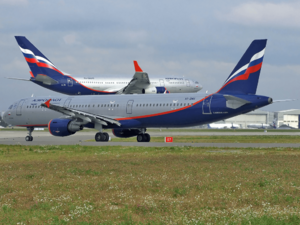
In December 2009, after it filed for bankruptcy, Aeroflot-Cargo merged into Aeroflot.
In November 2011, Rostec, a state agency, merged five airlines it owned - Vladivostok Avia, Saravia, Rossiya Airlines, SAT Airlines and Orenair - into Aeroflot, acquiring an additional 3.5% of the company in a ₽2.5 billion deal. Saravia was then sold to private investors. In September 2013, Aurora (originally called Taiga) was created, combining Vladivostok Air and SAT Airlines.
In June 2013, at the World Airline Awards which took place at the 50th Le Bourget air show, Aeroflot was awarded the international prize as the best air carrier in Eastern Europe.
In October 2013, the company introduced an affiliated low-cost carrier (LCC), Dobrolet. It started operations in June 2014; however, it ceased on 4 August 2014 due to EU sanctions over the airline launching flights to Crimea. In late August 2014, Aeroflot announced the launch of Pobeda, a new LCC to replace Dobrolet using aircraft transferred from Orenair. It started operations from Vnukovo Airport in December 2014.
In March 2014, as a response to the Revolution of Dignity, the company announced rerouting of flights to avoid flying over Ukraine. Also, in March 2014, Aeroflot's IATA airline designator ″SU″ was adopted by its subsidiary Rossiya. In September 2015, Aeroflot agreed to acquire 75% of Transaero Airlines for the symbolic price of ₽1, but abandoned the plan after failing to come to terms on a takeover. Aeroflot instead took over several of Transaero's aircraft by assuming its leases after Transaero ceased operations in December 2015, introducing the Boeing 747 and Boeing 777 to the Aeroflot fleet and allowing the company to cancel some of its jet orders.
Subsidiaries Rossiya Airlines, Donavia and Orenair combined operations in late March 2016. Orenair's AOC was cancelled by Russian authorities in late May 2016. Donavia and Orenair were declared bankrupt in 2017.
In June 2018, the company signed a codeshare agreement with Aerolineas Argentinas.
In December 2020, the company sold its 51% stake in Aurora to Sakhalin Region Development Corporation for ₽1.
2022 airspace bans and sanctions
In February and March 2022, as a result of the Russian invasion of Ukraine, Aeroflot and other Russian airlines were banned from the airspace of many countries and several routes were cancelled as a result. Russian airlines were added to the list of air carriers banned in the European Union for safety reasons because planes were re-registered in Russia and no longer had foreign airworthiness certificates. The U.S. Department of Commerce banned companies from servicing Boeing planes operated by Aeroflot, Aviastar, Azur Air, Belavia, Rossiya and Utair. Manchester United F.C. cancelled its sponsorship agreement that made Aeroflot its official carrier since July 2013. Sabre Corporation and others removed access by Aeroflot to their computer reservation systems and global distribution systems.
In response to the international sanctions during the Russian invasion of Ukraine, Aeroflot migrated to a Russian-based passenger service system, began sourcing aircraft parts via obscure trading companies, free-trade zones and middlemen in countries that have not imposed sanctions on Russia such as United Arab Emirates and China, and placed orders for Russian-made jets such as the Yakovlev MC-21 to reduce its dependence on foreign-made jets.
In September 2023, Aeroflot paid $645 million to acquire 17 aircraft and five spare jet engines that were leased to Aeroflot and owned by AerCap and were stranded in Russia upon the Russian invasion of Ukraine.
Corporate affairs
Management history
Management of the company is appointed by the Russian government due to its ownership stake.
Chief executive officers
- Yevgeny Shaposhnikov (November 1995 - March 1997)
- Valery Okulov, a son-in-law of Boris Yeltsin (May 1997 - March 2009)
- Vitaly Savelyev (2009 - 2020)
Chairmen
- Yevgeny Dietrich (2018 - 2020)
Headquarters
The headquarters of Aeroflot are on Arbat Street, Arbat District, Central Administrative Okrug, Moscow.
Ownership and subsidiaries
The Federal Agency for State Property Management, an agency of the Government of Russia, owns 73.77% of the company, with the rest of the shares being public float.
The company owns airline subsidiaries Pobeda and Rossiya Airlines.
Destinations
In September 2018, Aeroflot served 146 destinations in 52 countries. In 2022, the number of destinations was significantly reduced after many countries banned Russian aircraft as a result of the Russian invasion of Ukraine. It currently operates service to/from Armenia, Azerbaijan, Belarus, China, Cuba, Egypt, Hong Kong, India, Iran, Kazakhstan, Kyrgyzstan, Maldives, Mauritius, Seychelles, Sri Lanka, Thailand, Turkey, United Arab Emirates, Uzbekistan, and Vietnam.
Alliances
Aeroflot was a member of SkyTeam airline alliance from April 2006 until 27 April 2022, when its membership was suspended as part of the corporate responses to the Russian invasion of Ukraine.
Aeroflot's cargo branch, Aeroflot-Cargo, which was reintegrated into the parent company in December 2009, operated as part of SkyTeam Cargo.
Aeroflot has active codeshare agreements only with Aurora, Pobeda, and Rossiya Airlines.
Frequent flyer programme
Aeroflot's frequent-flyer program is called Aeroflot Bonus. It has four levels with various perks.
Fleet
The Aeroflot fleet consists of narrow-body and wide-body aircraft from five aircraft families: the Airbus A320, the Airbus A330, the Airbus A350 XWB, the Boeing 737, and the Boeing 777. The fleet, excluding subsidiaries, includes 171 airplanes: 112 Airbus planes and 59 Boeing planes. The company plans on making the Yakovlev MC-21 its flagship plane, with deliveries expected to start in 2025 or 2026.
Accidents and incidents
Aeroflot has had a total of 8,231 passengers dying in Aeroflot crashes according to the Aircraft Crashes Record Office, mostly during the Soviet era, about five times more than any other airline. From 1946 to 1989, the carrier was involved in 721 incidents. In 2013, AirlineRatings.com reported that five of the ten aircraft models involved in the highest numbers of fatal accidents were old Soviet models. From 1992 to 2020, the carrier was involved in 14 incidents; since 1996, only two incidents have resulted in fatalities.
See also
 In Spanish: Aeroflot para niños
In Spanish: Aeroflot para niños



